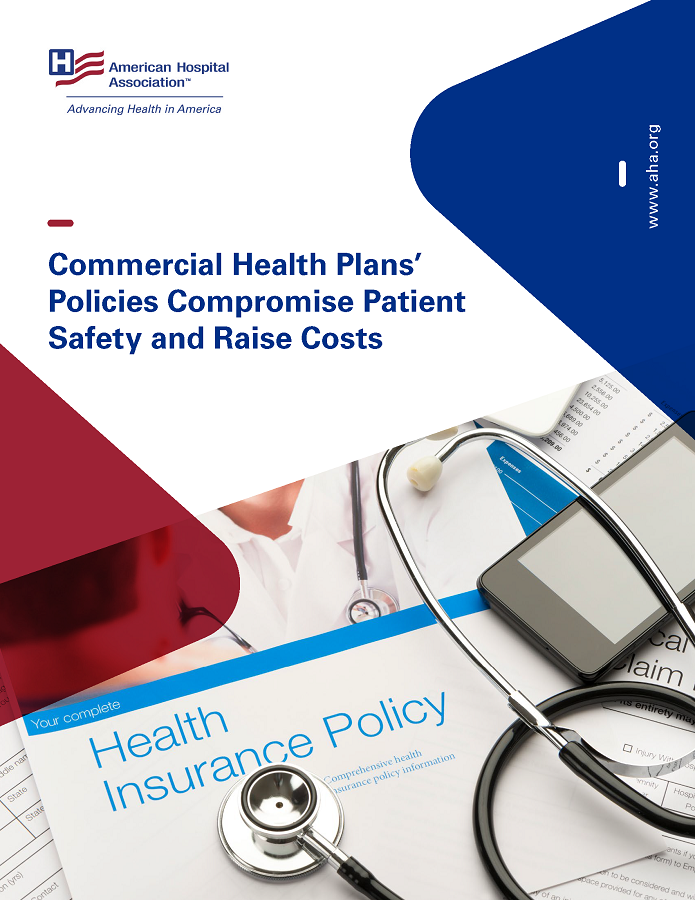Private commercial health insurance coverage has long been the central pillar of our national health insurance system. Not only are commercial health insurance plans the primary source of health coverage for most Americans and employers, but Medicare and Medicaid programs often rely on private health insurance plans to manage their health benefits.
The cost of commercial insurance is rising at an unsustainable rate, overwhelming individuals and families, employers and government programs. The average family insurance premium has increased 47% over the past 11 years, faster than general inflation and more than any other part of the health care system.I This contrasts with hospital prices, which have risen an average of 2.1% per year over the past decade, about half of the average annual increase in health insurance premiums. And, more recently, hospital prices have risen much more slowly than the overall rate of inflation.ii
Key points to remember
- Many health plans enforce prior authorization requirements in a way that creates dangerous delays in care, contributes to clinician burnout, and significantly increases administrative costs to the health care system.
- Insurers often require patients to undergo periods of ineffective treatment before allowing access to the most appropriate therapy. The use of step therapy or fail-first policies is increasing, and its inappropriate application often results in short-term savings for insurers while increasing the administrative burden on providers and adding downstream costs due to patient delays and complications.
- Insurers frequently establish flawed or overly strict medical necessity policies that prevent patients from obtaining the necessary care recommended by their doctor.
- Many commercial insurers leverage their market power and position to induce providers to purchase their ancillary products which increase administrative costs and line insurers’ pockets.
- White bagging is an insurer practice that effectively prohibits a provider from using its own drug inventory to supply the drugs used to treat patients at its facility and prohibits providers from monitoring supply processes, storage and handling, which has important implications for safety and efficiency. .
- Many insurers use electronic payment methods that require providers to deposit money to receive their contractual reimbursements from commercial insurers. Insurers often receive incentives from credit card companies or payment providers to issue these payments. Suppliers shouldn’t have to pay to get paid.
Need for action
Some commercial health insurers have implemented policies that add billions of dollars in unnecessary administrative costs to the health care system while compromising patient care. Abuses of commercial health plans must be addressed to protect patient health and ensure that healthcare professionals, not the insurance industry, make key decisions about patient care.
Commercial insurer policies that hurt patients and increase costs
Several under-examined features of commercial health insurance contribute to unsustainable cost growth – many of which are at best unnecessary and at worst detrimental to patient health and workforce well-being. Insurers’ use of policies that deny or delay medically necessary care — often applauded by insurers as ways to control costs — has become enormously burdensome for hospitals, providers, and patients.
The massive administrative costs are largely due to the complex payment and reporting requirements of various commercial health insurers.iii More frequently, they include the excessive and unwarranted application of usage management tools and prior authorization requirements. These practices increase costs by slowing the delivery of care, forcing providers to purchase additional IT tools, and forcing them to hire additional staff to manage needs.
Ironically, many commercial health insurers emphasize these processes and requirements as part of their efforts to manage healthcare spending. What is often overlooked are the complicated commercial and financial relationships between many health insurers and intermediary service providers.
For example, the three largest Pharmacy Benefit Managers (PBMs) are owned by commercial health insurers. The administrative services and heavy data analysis company Optum generates more revenue for UnitedHealth Group than its commercial health insurance arm, UnitedHealthcare (UHC), although UHC is the nation’s largest commercial health insurer. These complex relationships create potential conflicts of interest. More specifically, the insurer can put in place an administrative requirement on the suppliers that motivates the supplier’s need to obtain the tool or service from the intermediary.
As the nation strives to improve the affordability of America’s healthcare system, making healthcare plans more accountable will help reduce unnecessary expenditures on administrative processes and services while simultaneously improving patient access to care and reducing the excessive burden on our health personnel.
- First, we recommend identifying and measuring unnecessary administrative costs due to health plan abuses and excessive demands. Currently, much of this information is reflected in national datasets as spending on hospitals, health systems and doctors, as they are the ones who have to absorb the cost of staff compensation and medical care. acquiring the expensive products needed to comply with these commercial health insurance policies.
- Second, we must adopt policies to streamline, standardize and reform these cumbersome processes to reduce administrative inefficiencies.
“ A 2019 AHA survey of hospitals found that a large, the national hospital system spends $15 million a month on administrative costs related to changes in the insurer’s prior authorization. The system employs two to three full-time staff just to monitor insurers’ bulletins for changes to their pre-authorization rules.
The full report provides information on areas with the most room for improvement.
- Kaiser Family Foundation, “2021 Employer Health Benefits Survey.” Available at: https://www.kff.org/report-section/ehbs-2021-section-1-cost-of-health-insurance/
- American Hospital Association, “Massive spending growth and rising inflation fuel continued financial challenges for American hospitals and healthcare systems.” Available at: https://www.aha.org/system/files/media/file/2022/04/2022-Hospital-Expenses-Increase-Report-Final-Final.pdf
- William H. Shrank. Waste in the American Health Care System, Journal of the American Medical Association. Available at: https://jamanetwork.com/journals/jama/article-abstract/2752664

